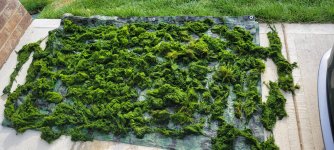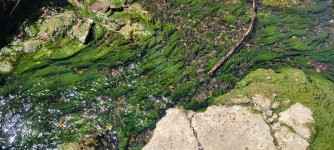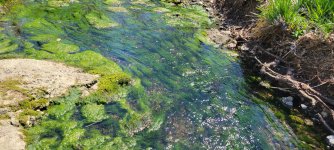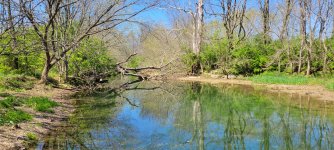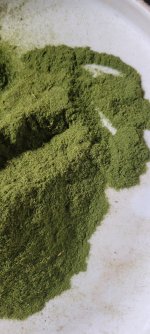-
Happy Birthday ICMag! Been 20 years since Gypsy Nirvana created the forum! We are celebrating with a 4/20 Giveaway and by launching a new Patreon tier called "420club". You can read more here.
-
Important notice: ICMag's T.O.U. has been updated. Please review it here. For your convenience, it is also available in the main forum menu, under 'Quick Links"!
You are using an out of date browser. It may not display this or other websites correctly.
You should upgrade or use an alternative browser.
You should upgrade or use an alternative browser.
Filamentous Algae as kelp substitute
- Thread starter UGDoCV
- Start date
experienced
Active member
Looks like (from the absence of replies) you're a pathfinder.
Where I am the green stuff feeds mullet. Not that they're a rich fish, or very big, but seems to me the green stuff must have unique qualities because it's part of the annual cycle of stream flows here. BUT how will that affect my garden .... ?
Hard to see that mulching or mixed in would do any harm.
Where I am the green stuff feeds mullet. Not that they're a rich fish, or very big, but seems to me the green stuff must have unique qualities because it's part of the annual cycle of stream flows here. BUT how will that affect my garden .... ?
Hard to see that mulching or mixed in would do any harm.
Now this is a cool idea! Some algae have very nice balance of trace and micro nutrients, as well as som n and k. Plus, if it’s freshwater it probably won’t be loaded with sodium like kelp.Anyone collected the seaweed like algae in freshwater streams and used as fertilizer? I have access to an ever growing supply that I have collected recently, rinsed, dried, dehydrated and ground into powder like a kelp meal.
Agree that it’s probably a good idea to make sure it’s dead, maybe toast it after it’s dry. Or put it in a hot trunk for a few days in a trash bag (dry of course). Cool idea, please let us know how it goes!
For my use I looked up seaweed processing for dried kelp and immediately rinse the stuff, lay it out an a tarp in sun for several days, dried more at 170 in oven, blended into a powder. I do similiar with egg shells. Most of this was completely submerged in moving water as its easier to pull. Stuff supports entire an ecosystem with all the critters around. Maybe outside gardening I would just lay a layer 3 or 4 inches deep of rinsed and dried outside material but for my purpose I'd rather have dried ground material. I have been waiting all winter to try this particular stuff after trying to buy 50lb kelp meal over winter, lol. Water feeds through farmland and a golf course.
Attachments
Last edited:
greyfader
Well-known member
these types of algae do not accumulate toxins so should be safe to use.
these types of algae do not accumulate toxins so should be safe to use.
I have added it at about tbsp of powder per gallon soil to a couple of large bins of my soil that is recharging and top dressed other plants and veggies.
I am late to chatgpt "Both filamentous algae and kelp powder can be suitable as soil amendments when making your own organic mix, depending on the specific needs of your plants and the composition of your soil.
Kelp powder is particularly rich in minerals such as potassium, magnesium, and calcium, which are essential for healthy plant growth. It also contains growth hormones and other beneficial compounds that can promote root development and increase overall plant vitality. Kelp powder is often used to improve soil structure, increase nutrient uptake, and enhance resistance to environmental stressors such as drought or disease.
Filamentous algae, on the other hand, is particularly rich in nitrogen, phosphorus, and other key nutrients that are essential for plant growth and development. It can also contain beneficial compounds such as amino acids and polyphenols that can enhance plant health and increase resistance to pests and diseases. Filamentous algae is often used as a soil amendment to improve fertility and increase microbial activity in the soil.
Ultimately, the choice between filamentous algae and kelp powder as a soil amendment will depend on the specific needs of your plants and soil. If your soil is lacking in minerals or you are looking to promote root development and overall plant vitality, kelp powder may be the better choice. If you are looking to increase the fertility of your soil and improve microbial activity, filamentous algae may be more suitable.
It's also worth noting that both filamentous algae and kelp powder can be used in combination with other organic soil amendments such as compost, bone meal, or rock dust to create a well-rounded and nutrient-rich soil mix. When using any soil amendment, it's important to follow the recommended application rates and consult with a gardening expert or soil testing service to ensure that you are providing your plants with the optimal growing conditions."
Kelp powder is particularly rich in minerals such as potassium, magnesium, and calcium, which are essential for healthy plant growth. It also contains growth hormones and other beneficial compounds that can promote root development and increase overall plant vitality. Kelp powder is often used to improve soil structure, increase nutrient uptake, and enhance resistance to environmental stressors such as drought or disease.
Filamentous algae, on the other hand, is particularly rich in nitrogen, phosphorus, and other key nutrients that are essential for plant growth and development. It can also contain beneficial compounds such as amino acids and polyphenols that can enhance plant health and increase resistance to pests and diseases. Filamentous algae is often used as a soil amendment to improve fertility and increase microbial activity in the soil.
Ultimately, the choice between filamentous algae and kelp powder as a soil amendment will depend on the specific needs of your plants and soil. If your soil is lacking in minerals or you are looking to promote root development and overall plant vitality, kelp powder may be the better choice. If you are looking to increase the fertility of your soil and improve microbial activity, filamentous algae may be more suitable.
It's also worth noting that both filamentous algae and kelp powder can be used in combination with other organic soil amendments such as compost, bone meal, or rock dust to create a well-rounded and nutrient-rich soil mix. When using any soil amendment, it's important to follow the recommended application rates and consult with a gardening expert or soil testing service to ensure that you are providing your plants with the optimal growing conditions."
I have added it at about tbsp of powder per gallon soil to a couple of large bins of my soil that is recharging and top dressed other plants and veggies.

